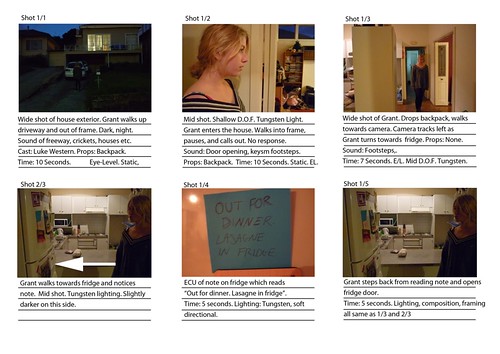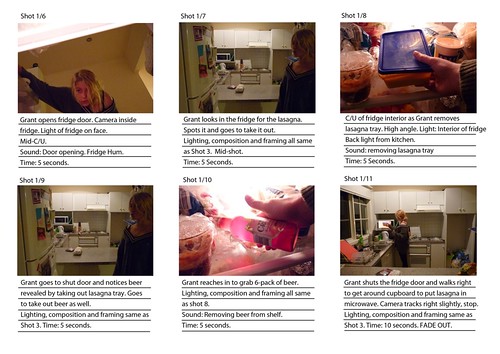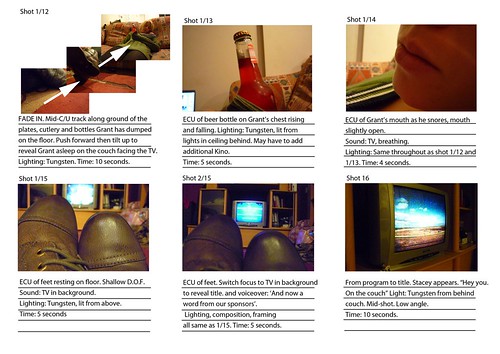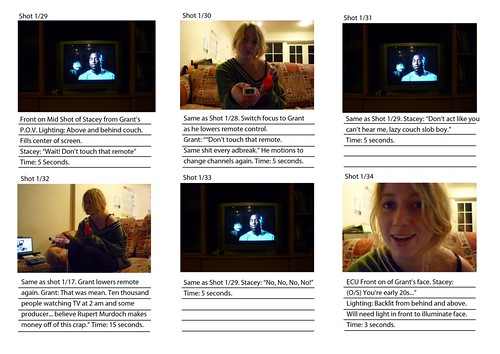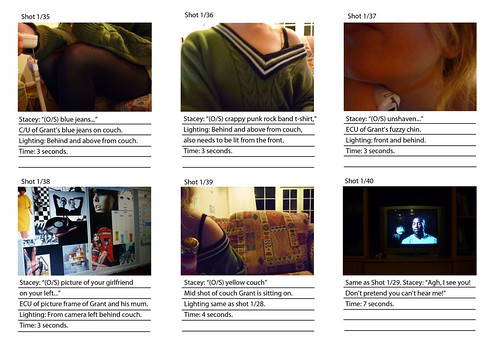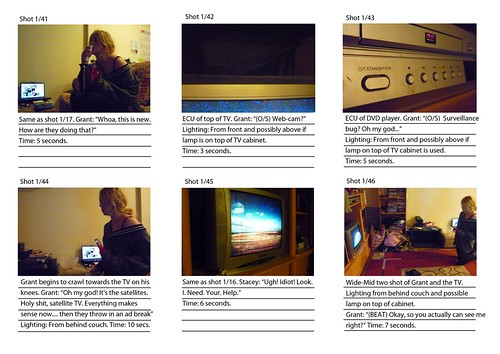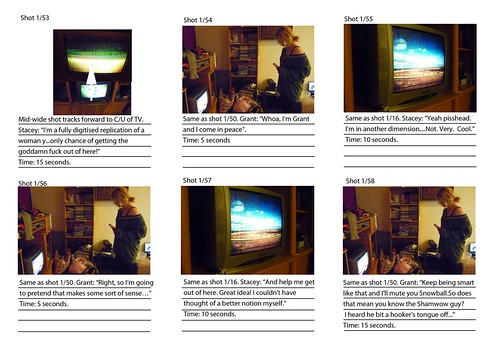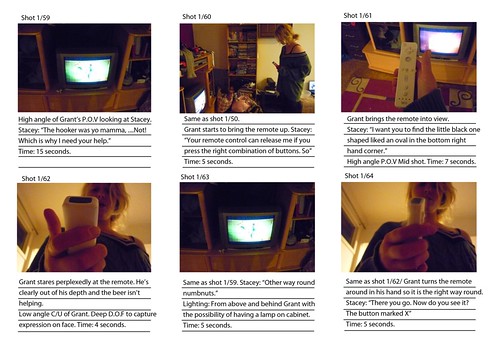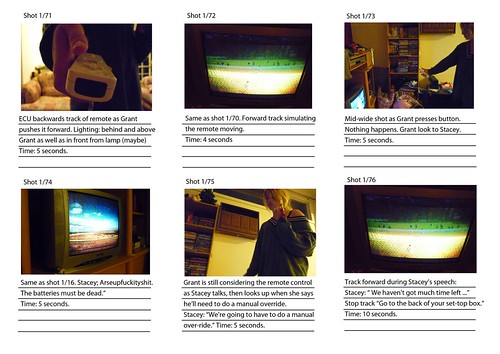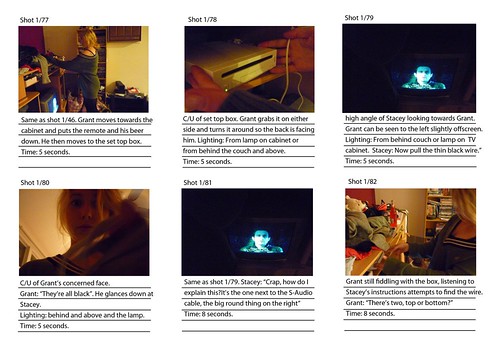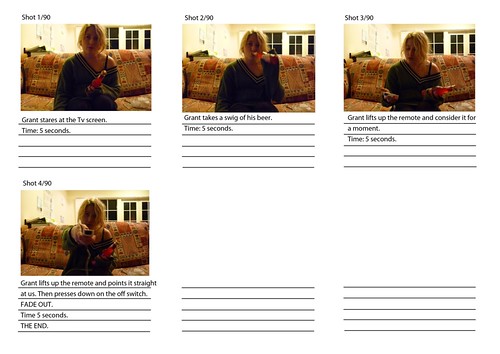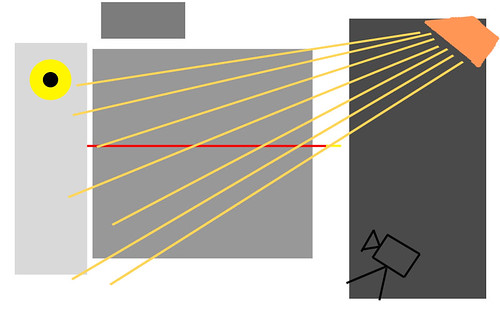It's excruciatingly painful to have to go through 12 weeks of pre-production work, filming, and editing only to come out the other end to have everyone say something along the lines of "what a shame about..." Unfortunately for our group, this was the exact case for our film Under Control. We knew sound was going to be an issue from all the things that had gone wrong last week during post-production but to be honest, I wasn't expecting it to be as bad as it was. From that obvious popping during the MP3 clips, to the out-of-sync dialogue, to the sound at the end just being way too loud, it really was a shame that our entire project had been completely screwed up by one tiny decision. I am seriously considering a short course in music production for film now as a result so that I don't make the same mistake again next time.
Anyway, other than that, the rest of the night was relatively pleasant. I had to admit by the third sneaker spastic, I was nearly ready to throw something at the screen but that had nothing to do with the films - I was slightly hungover and had only had 2 hours sleep and in general, hate watching the same narrative more than once in a year. It's why I don't watch the same film twice if I can avoid it. I think the entire semester would have been more interesting if a rule had been put in place to limit the number of a times a film could be made. Yes, I will concede that some scripts that were better than others but that did not dictate who made which films. In fact, only 5 out of the 10 of the scripts on Christine's Top 10 List were made with 9 of the 20 films being made from those 5 scripts. Personally, I wondered what these production groups could have done had they been forced to make another script rather than a variation of one already being made.
Regardless, I did come out of theatre with some favourites. They included Neurotic Meets Normality, The Last Shift, and Lucky Game.
Whilst I am still a little confused over the motivation for the ending of Neurotic Meets Normality, I was absolutely blown away by its cinematography. The supremely executed extreme close-ups, wonderful use of colour and and all round good eye for detail meant the film just looked brilliant. I also loved the sequence with the voiceover counting the number of steps the man takes to work, simulating his thoughts. The timing was perfect and it was really such a powerful scene and to be able to literally get inside the head of that type of character, set up the scene in the elevator really well.
The Last Shift was another one of my favourites for cinematographic reasons but also because it had me on the edge of my seat the whole way throughout. I knew the script from reading it 12 weeks ago and did think it was a good idea at the time but a little clichéd at the same time. This groups version of it however, made me completely forget about the fact that it was a overdone story. Timing and editing were definitely contributing factors towards this and coupled with an excellent use of lighting, made the whole film really scary. I loved the last shot which although heavily overused in horror films, still got me.
Finally, my favourite film of the night: Lucky Game. At the beginning of this film, I had to admit I was really pre-occupied with the internal conversation going on in my brain over whether I had seen one of the little boys in a short film from SKFF but eventually, I gave up and got into the story. It's lucky I did because this little film was a beauty. I loved the concept of two siblings being in a power struggle with the underdog coming out on top, the reminiscent feeling you get of dealing with your brother or sister knowing we have all been in a similar situation before, and finally, the classic black comedy twist at the end. I think the film would have been heavily aided by some more color correction but the camera work and editing made up for this. All in all, this was my favourite film of the night and one that had me chuckling for a while afterwards.
In a final reflection, if I was to do this semester again, there would have been a number of things I would have done differently. Firstly, I would not have been afraid of change: I realise now its vital one can recognise when they are in need of some serious help and ego can not get in the way of this occurring. I am extremely grateful that Arthur offered to assist us with the camerawork because at the end of the day, I think that's what saved our film. Secondly, I would have been way more concerned with sound. It is the other half to any film and if you are not concentrating on both it and the image, then you are only doing half the work. Finally, I would have appreciated more time. This would have been available to us this semester had we not had all the issues with scripts changes last-minute and generally not getting off our ass quick enough to get into motion but I think in the time frame we had, things worked out OK.
This entire semester has been a complete rollercoaster ride for me from losing my laptop, iPod and wallet, to going through some ridiculously heavy personal issues, whilst attempting to maintain my work quality for all my other subjects, I think I only just survived. Having said that, I would do it all again. I've learnt many things this semester that I will be able to apply to my future career and my stint at the University of Florida next semester, something that has been getting me through the last painful 4 weeks. I'm looking forward to coming home next year full of new experiences, raring and ready to go for our final year. Until then, farewell my fellow filmbuffs.
Anyway, other than that, the rest of the night was relatively pleasant. I had to admit by the third sneaker spastic, I was nearly ready to throw something at the screen but that had nothing to do with the films - I was slightly hungover and had only had 2 hours sleep and in general, hate watching the same narrative more than once in a year. It's why I don't watch the same film twice if I can avoid it. I think the entire semester would have been more interesting if a rule had been put in place to limit the number of a times a film could be made. Yes, I will concede that some scripts that were better than others but that did not dictate who made which films. In fact, only 5 out of the 10 of the scripts on Christine's Top 10 List were made with 9 of the 20 films being made from those 5 scripts. Personally, I wondered what these production groups could have done had they been forced to make another script rather than a variation of one already being made.
Regardless, I did come out of theatre with some favourites. They included Neurotic Meets Normality, The Last Shift, and Lucky Game.
Whilst I am still a little confused over the motivation for the ending of Neurotic Meets Normality, I was absolutely blown away by its cinematography. The supremely executed extreme close-ups, wonderful use of colour and and all round good eye for detail meant the film just looked brilliant. I also loved the sequence with the voiceover counting the number of steps the man takes to work, simulating his thoughts. The timing was perfect and it was really such a powerful scene and to be able to literally get inside the head of that type of character, set up the scene in the elevator really well.
The Last Shift was another one of my favourites for cinematographic reasons but also because it had me on the edge of my seat the whole way throughout. I knew the script from reading it 12 weeks ago and did think it was a good idea at the time but a little clichéd at the same time. This groups version of it however, made me completely forget about the fact that it was a overdone story. Timing and editing were definitely contributing factors towards this and coupled with an excellent use of lighting, made the whole film really scary. I loved the last shot which although heavily overused in horror films, still got me.
Finally, my favourite film of the night: Lucky Game. At the beginning of this film, I had to admit I was really pre-occupied with the internal conversation going on in my brain over whether I had seen one of the little boys in a short film from SKFF but eventually, I gave up and got into the story. It's lucky I did because this little film was a beauty. I loved the concept of two siblings being in a power struggle with the underdog coming out on top, the reminiscent feeling you get of dealing with your brother or sister knowing we have all been in a similar situation before, and finally, the classic black comedy twist at the end. I think the film would have been heavily aided by some more color correction but the camera work and editing made up for this. All in all, this was my favourite film of the night and one that had me chuckling for a while afterwards.
In a final reflection, if I was to do this semester again, there would have been a number of things I would have done differently. Firstly, I would not have been afraid of change: I realise now its vital one can recognise when they are in need of some serious help and ego can not get in the way of this occurring. I am extremely grateful that Arthur offered to assist us with the camerawork because at the end of the day, I think that's what saved our film. Secondly, I would have been way more concerned with sound. It is the other half to any film and if you are not concentrating on both it and the image, then you are only doing half the work. Finally, I would have appreciated more time. This would have been available to us this semester had we not had all the issues with scripts changes last-minute and generally not getting off our ass quick enough to get into motion but I think in the time frame we had, things worked out OK.
This entire semester has been a complete rollercoaster ride for me from losing my laptop, iPod and wallet, to going through some ridiculously heavy personal issues, whilst attempting to maintain my work quality for all my other subjects, I think I only just survived. Having said that, I would do it all again. I've learnt many things this semester that I will be able to apply to my future career and my stint at the University of Florida next semester, something that has been getting me through the last painful 4 weeks. I'm looking forward to coming home next year full of new experiences, raring and ready to go for our final year. Until then, farewell my fellow filmbuffs.




